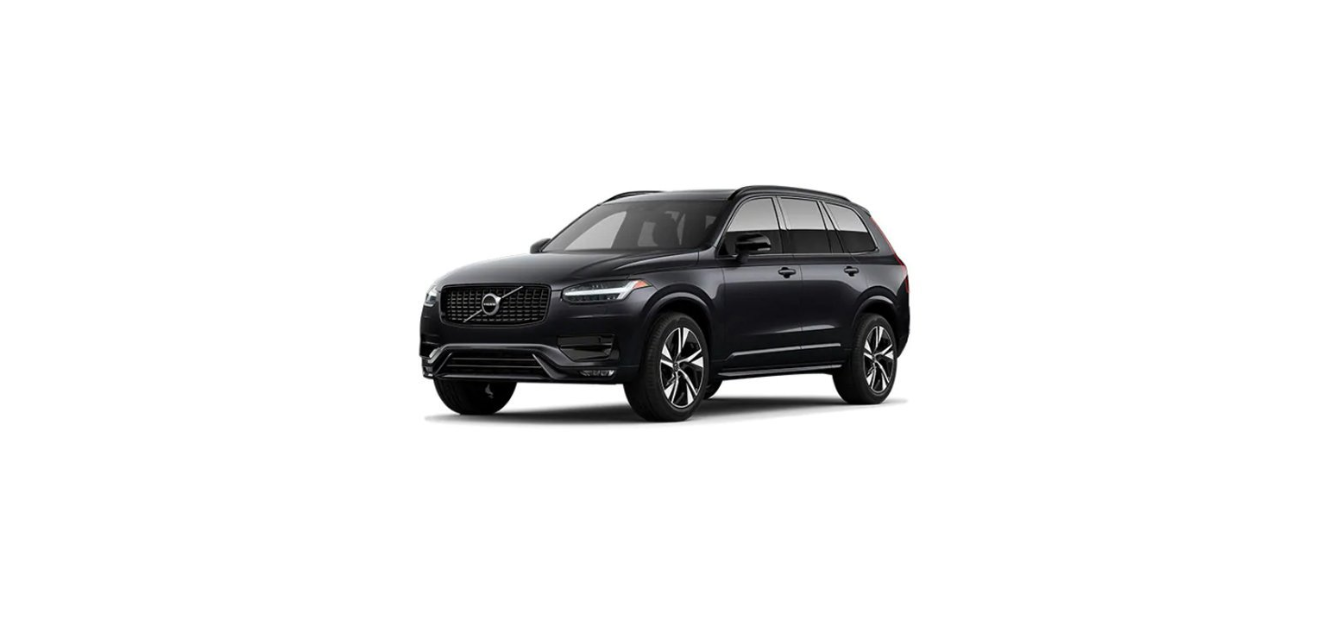2022 XC90 Volvo Camera and radar unit
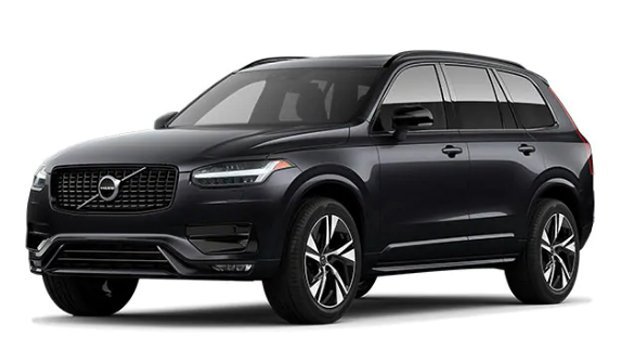
Recommended maintenance for camera and radar units
In order that the camera and radar units shall function correctly, they must be kept clear of dirt, ice and snow, and be cleaned regularly with water and car shampoo.
Note
Dirt, ice and snow covering the sensors may cause incorrect warning signals, and reduced or no function.
The following illustrations mark out the surfaces to be kept clean – on both the left and right-hand sides of the car.
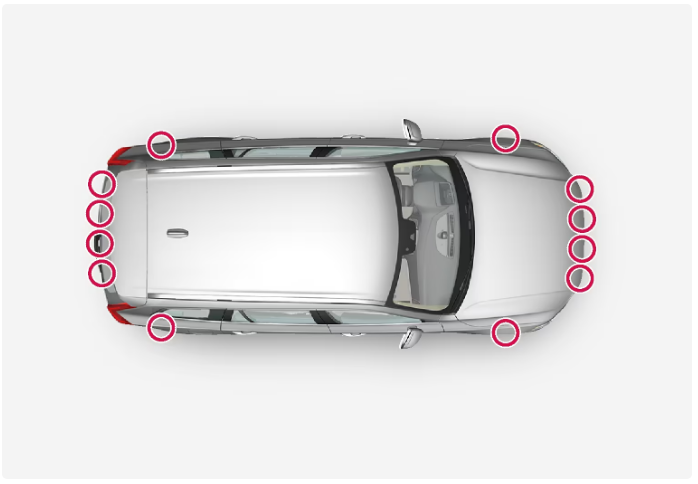 Location of the parking sensors around the car
Location of the parking sensors around the car
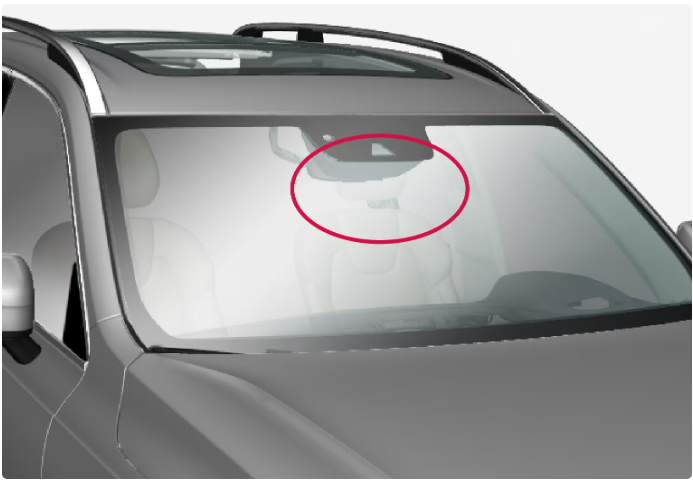 Location of front camera and radar unit
Location of front camera and radar unit
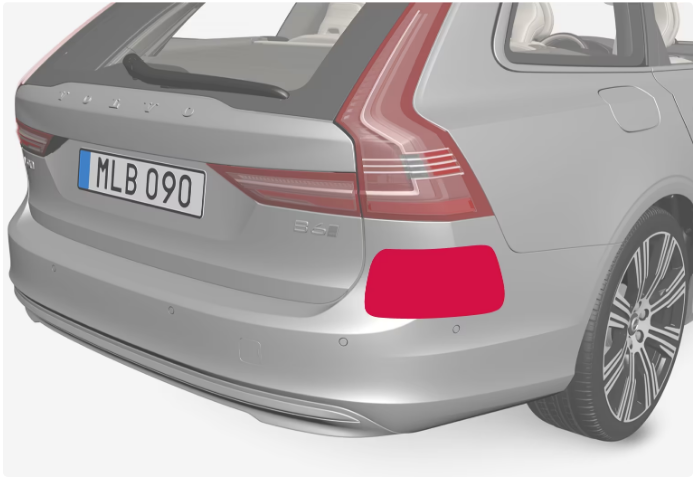 Location of rear radar units
Location of rear radar units
- To ensure best possible functionality, the surfaces in front of the sensors must be kept clean.
- Do not affix any objects, tape or labels in the area of the sensors.
- Clean camera lenses regularly with lukewarm water and car shampoo – be careful not to scratch the lenses.
Important
Maintenance of driver support components must only be performed at a workshop – an authorised Volvo workshop is recommended.
Symbols and messages for camera and radar units
Here are examples of some of the display messages and symbols regarding the camera and radar that can be shown in the driver display.
Detector blocked

If the driver display shows this symbol and the message Windscreen sensor Sensor blocked, see Owner’s manual, this means that the camera and radar unit cannot detect other vehicles, cyclists, pedestrians and large animals in front of the car, and that the car’s camera-based and radar-based functions may be disrupted.
The following table presents examples of possible causes for a message being shown, along with the appropriate action:
| Cause | Action |
|---|---|
| The windscreen surface in front of the camera and radar unit is dirty or covered with ice or snow. | Clean dirt, ice and snow from the windscreen surface in front of the camera and radar unit. |
| Thick fog and heavy rain or snow block the radar signals or the camera view. | No action. Sometimes the unit does not work during heavy rain or snowfall. |
| Water or snow from the road surface swirls up and blocks the radar signals or camera view. | No action. Sometimes the unit does not work on a very wet or snow-covered road surface. |
| Dirt has entered between the inside of the windscreen and the camera unit. | Visit a workshop to have the windscreen inside the unit’s cover cleaned – an authorised Volvo workshop is recommended. |
| Strong oncoming light | No action. The camera unit is reset automatically in more favourable light conditions. |
Defective camera

If a camera sector is black and contains this symbol then it means that the camera is out of order.
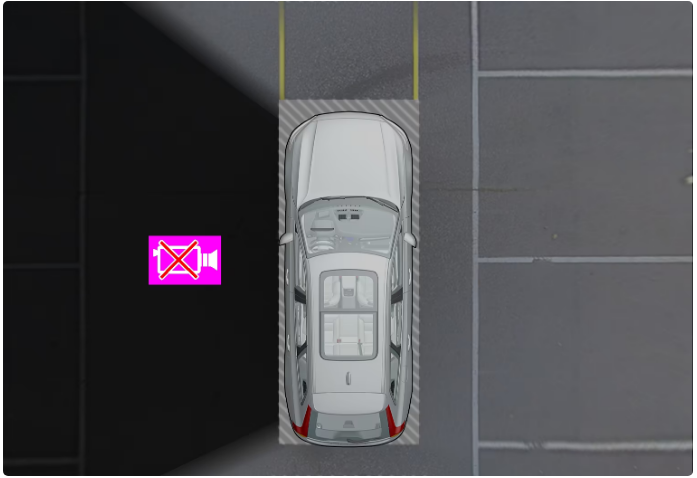 Example for showing when the car’s left camera is non-operational.
Example for showing when the car’s left camera is non-operational.
A black camera sector is also shown in the following instances, but then without the symbol for defective camera:
- open door
- open tailgate
- folded-in door mirror.
Rear parking camera
Warning

Pay additional attention while reversing when this symbol is shown if a trailer, bicycle rack or similar is mounted and electrically connected to the car.
The symbol indicates that the parking assistance sensors rearward are switched off and will not warn of any obstacles.
Limitations for camera and radar units
The camera and radar have certain limitations – which in turn also limits those functions that use the units. A driver should be aware about the following examples of limitations.
Common limitations for camera and radar
The camera and radar are aids for intelligent driving that cannot be called upon to achieve intelligent driving, and the necessary safety management must be implemented in order to avoid road safety risks or accidents caused by the driver’s incorrect use of the camera and radar.
Blocked unit
Do not position, stick or install anything in front of or around the camera and radar units – this may disrupt camera and radar-based functions. This may result functions being reduced, being switched off completely or giving incorrect function responses.
High temperature
At very high temperatures the camera and radar can temporarily be switched off for about 15 minutes after the engine is started so as to protect the unit’s electronics. The units restart automatically when the temperature has fallen sufficiently.
Damaged windscreen
The following rules are also applicable when a camera or radar is placed in the windscreen:
- If a scratch, crack or stone chip appears in front of the unit and covers an area of approx. 0.5 × 3.0 mm (0.02 × 0.12 inches) or more, a workshop must be contacted so that the windscreen can be replaced.
- Volvo recommends not repairing cracks, scratches or stone chips in the area in front of the unit – the entire windscreen should be replaced instead.
- Before replacing a windscreen, contact a workshop to verify that the correct windscreen has been ordered and will be fitted.
- The same type of windscreen wipers or windscreen wipers approved by Volvo must be fitted when the windscreen is replaced.
- When replacing the windscreen, the camera and radar unit must be recalibrated by a workshop to ensure the functionality of all the camera and radar-based systems in the car.
Note
If not rectified, it can lead to reduced performance for the driver support systems that use the camera and/or radar units. This may result functions being reduced, being switched off completely or giving incorrect function responses.
Further limitations for radar
Vehicle speed
The radar unit’s ability to detect a vehicle ahead is greatly reduced if the speed of the vehicle ahead is very different to the speed of your own car.
Limited field of vision
The radar unit has a limited field of vision. In some situations another vehicle is not detected, or the detection is made later than expected.
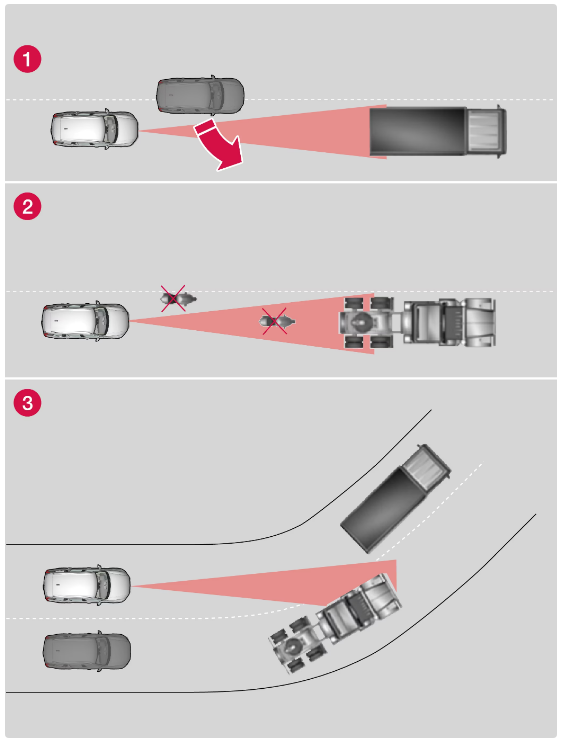 The radar unit’s field of vision
The radar unit’s field of vision
- Sometimes the radar unit is late at detecting vehicles at close distances – e.g. a vehicle that drives in between your car and the vehicle ahead.
- Small vehicles, such as motorcycles, or vehicles not driving in the centre of the lane can remain undetected.
- In bends, the radar unit may detect a different vehicle than intended or lose a detected vehicle from view.
Low trailers
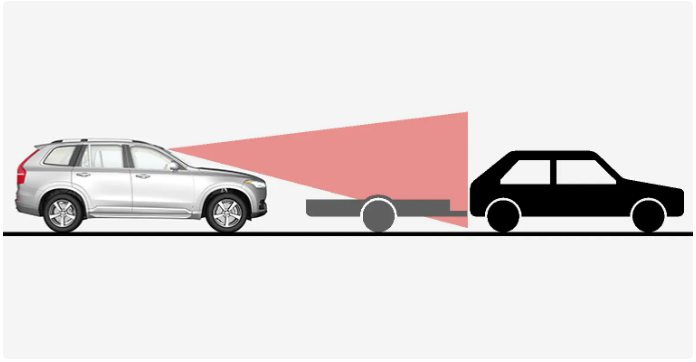 Low trailer in radar shadow
Low trailer in radar shadow
Low trailers can also be difficult for the radar unit to detect, or are not detected at all – the driver should therefore be particularly careful when driving behind low trailers when the adaptive cruise control or Pilot Assist is activated.
Further limitations for camera
Impaired vision
The cameras have limitations similar to the human eye, i.e. may “see” worse in for example intense snowfall or rain, dense fog, heavy dust storms and snow flurries. Under such conditions, the functions of camera-dependent systems could be significantly reduced or temporarily disengaged.
Strong oncoming light, reflections in the carriageway, snow or ice on the road surface, dirty road surfaces or unclear lane markings can also significantly reduce camera function when it is used to scan the carriageway to detect pedestrians, cyclists, large animals and other vehicles.
Bicycle racks or other accessories mounted at the rear of the car may obscure the camera’s view.
Further limitations for Park assist camera
Blind sectors
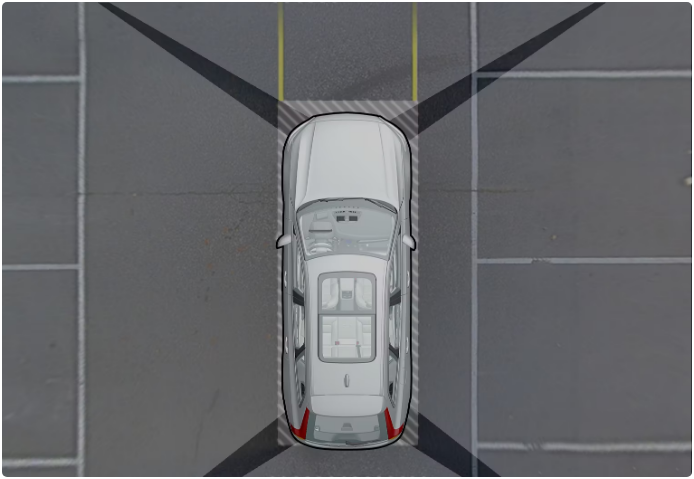 There are “blind” sectors between the cameras’ fields of vision.
There are “blind” sectors between the cameras’ fields of vision.
In the park assist camera’s 360° view obstacles/objects may “vanish” in the gaps between the individual cameras.
Warning
Pay attention to the possibility that, even if it only looks like a relatively small part of the image is obscured, a relatively large sector could be hidden from view. An obstacle could thereby go undetected until the car is very close to it.
Light conditions
The camera image is adjusted automatically according to prevailing light conditions. Because of this, the image may vary slightly in brightness and quality. Poor light conditions can result in reduced image quality.
Camera unit
The camera unit is used by several driver support systems and has the task of for example detecting lane lines or traffic signs.
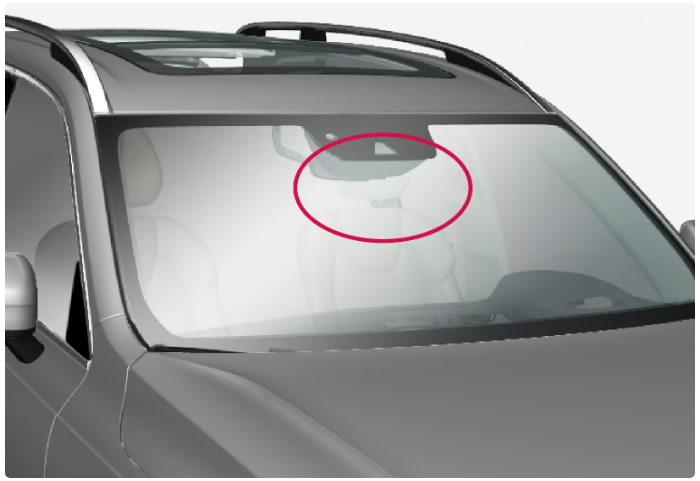 Location of the camera unit
Location of the camera unit
The camera unit is used by the following functions:
- Adaptive cruise control
- Pilot Assist
- Lane assistance
- City Safety
- Steering assistance at risk of collision
- Driver Alert Control
- Road Sign Information
- Active main beam
- Park Assist
Important
Do not attempt to access the camera using sharp or foreign objects through the air vents as this may damage the equipment.
Radar unit
Radar is used by several driver support systems and has the task of sensing other vehicles.
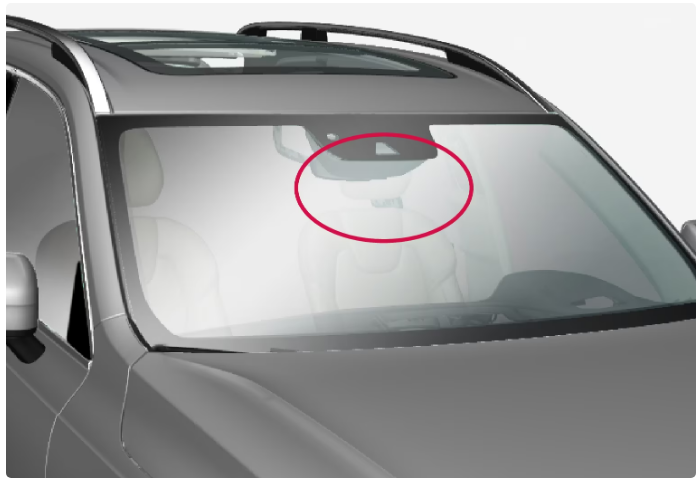 Location of front radar unit
Location of front radar unit
The radar unit is used by the following functions:
- Distance Warning
- Adaptive cruise control
- Pilot Assist
- Lane assistance
- City Safety
- Steering assistance at risk of collision
Modification of the radar unit could result in its use being illegal.
Type approval for radar device
Here you can find type approval for the car’s radar units for adaptive cruise control (ACC(Adaptive Cruise Control)), Pilot Assist(Option/accessory) and BLIS(Blind Spot Information).
| Market | ACC & PA | BLIS | Symbol | Type approval |
|---|---|---|---|---|
| Botswana | ✓ |
 |
||
| Brazil | ✓ |
 |
Este equipamento opera em caráter secundário, isto é, não tem direito à proteção contra interferência prejudicial, mesmo de estações do mesmo tipo, e não pode causar interferência a sistemas operando em caráter primário.
Modelo: L2C0054TR 4122-14-8645 EAN: (01)07897843840855 |
|
| ✓ | Este equipamento não tem direito à proteção contra interferência prejudicial e não pode causar interferência em sistemas devidamente autorizados.
03563-17-05364 |
|||
| Europe | ✓ |
 |
Hereby, Delphi Electronics and Safety declares that L2C0054TR / L2C0055TR are in compliance with the essential requirements and other relevant provisions of Directive 2014/53/EU (RED). The original declaration of conformity can be accessed at the following link www.delphi.com/automotive-homologation.
Frequency Band: 76GHz – 77GHz Maximum Output Power: 55dBm EIRP The Declaration of Conformity may be consulted at Delphi Electronics & Safety / 2151 E. Lincoln Road / Kokomo, Indiana 46902 USA |
|
| ✓ | Hereby, Hella KgaA Hueck & Co. Declares that the radio equipment type RS4 is in compliance with Directive 2014/53/EU.
The full text of the EU declaration of conformity is available at the following internet address: www.hella.com/vcc. Technical information: Frequency range: 24.05 … 24.25 GHz Transmission power: 20 dBm (maximum) EIRP Manufacturer and Address: Manufacturer: Hella KGaA Hueck & Co. Address: Rixbecker Straße 75, 59552 Lippstadt, Germany |
|||
| The United Arab Emirates (UAE) | ✓ |
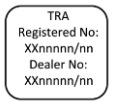 |
Registered No: ER37536/15
Dealer No: DA37380/15 |
|
| ✓ | Registered No: ER53878/17
Dealer No: DA44932/15 |
|||
| Ghana | ✓ | NCA Approved: 1R3-1M-7E1-0B7 | ||
| Indonesia | ✓ | 37295/POSTEL/2014
4927 |
||
| ✓ | Certificate number: 50459/SDPPI/2017
Country of origin Germany Certificate number: 53578/SDPPI/2017 Country of origin China PLG ID: 6051 |
|||
| Jamaica | ✓ | This product contains a Type Approved Module by Jamaica: SMA – “RS4”. | ||
| Jordan | ✓ | Type Approval No.: TRC/LPD/2014/255
Equipment Type: Low Power Device (LPD) |
||
| ✓ | Type Approval No.: TRC/LPD/2017/63
Equipment Type: Low Power Device (LPD) |
|||
| China | ✓ | 车辆驾驶辅助雷达系统型号: RS4型 微功率短距无线电传送设备分类:H类 频率范围:24.05-24.25GHz 放射功率: 20mW (等效全向辐射功率) 天线类型:集成型微带贴片阵列天线 用户控制:不可
不得擅自更改发射频率、加发射功率(包括额外加装射频功率放大器),不得擅自外接天线或改用其它发射天线 使用时不得对各种合法的无线电通信业务产生有害干扰;一旦发现有干扰现象时,应立即停止使用,并采取措施消除干扰后方可继续使用 使用微功率无线电设备,必须耐受各种无线电业务的干扰或工业、科学及医疗应用设备的辐射干扰 不得在飞机和机场附近使用。 |
||
| Malaysia | ✓ |
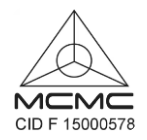 |
CID F 15000578 | |
| Morocco | ✓ | AGREE PAR L’ANRT MAROC
NUMÉRO D’AGRÉMENT: MR 9929 ANRT 2014 DATE D’AGRÉMENT: 26/12/2014 |
||
| Mexico | ✓ | IFETEL: RLVDEL215-0299 | ||
| ✓ | Radar de corto alcance
RS4 Hella KGaA Hueck & Co IFETEL: RLVHERS17-0286 La operación de este equipo esta sujeta a las siguientes dos condiciones: (1) es posible que este equipo o dispositivo no cause interferencia perjudicial y (2) este equipo o dispositivo debe aceptar cualquier interferencia, incluyendo la que pueda causar su operación no deseada. |
|||
| Moldova | ✓ | ✓ |
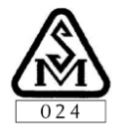 |
|
| Nigeria | ✓ | Connection and use of this communications equipment is permitted by the Nigerian Communications Commission. | ||
| Oman | ✓ |
 |
||
| Russia | ✓ |
 |
||
| Serbia | ✓ |
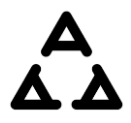 |
И011 14 | |
| ✓ | И011 17 | |||
| Singapore | ✓ |
 |
DA 105753 | |
| ✓ | DA 103238 | |||
| South Africa | ✓ |
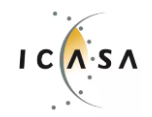 |
TA-2014/1824 | |
| ✓ | TA-2016/3407 | |||
| South Korea | ✓ |
 |
Certification No.
MSIP-CMI- DPH-L2C0054TR |
|
| ✓ | R-CMM-HLA-RS4
이 기기는 업무용(A급) 전자파 적합기기로서 판 매자 또는 사용 자는 이 점을 주의하시기 바 라며, 가정외의 지역에서 사용 하는 것을 목적으 로 합니다 |
|||
| Taiwan | ✓ |
 |
CCAB15LP0560T3 | |
| ✓ | CCAB17LP0470T5
警語 經型式認證合格之低功率射頻電機,非經許可,公司、商號或使用者均不得擅自變更頻率、加 大功率或變更原設計之特性及功能。 低功率射頻電機之使用不得影響飛航安全及干擾合法通信;經發現有干擾現象時,應立即停用 ,並改善至無干擾時方得繼續使用。 前項合法通信,指依電信法規定作業之無線電通信。低功率射頻電機須忍受合法通信或工業、 科學及醫療用電波輻射性電機設備之干擾 |
|||
| Thailand | ✓ | เครื่องโทรคมนาคมและอุปกรณ์นี้ มีความสอดคล้องตามมาตรฐานหรือข้อกำหนดของ กสทช. เครื่องวิทยุคมนาคมนี้มีระดับการแผ่คลื่นแม่เหล็กไฟฟ้าสอดคล้องตามมาตรฐานความปลอดภัยต่อสุขภาพของมนุษย์จากการใช้เครื่องวิทยุคมนาคมที่คณะกรรมการกิจการโทรคมนาคมแห่งชาติประกาศกําหนด | ||
| Ukraine | ✓ |
 |
Delphi цім стверджує, що обладнання RACAM/SRR2 відповідає вимогам Про затвердження Технічного регламенту радіообладнання і телекомунікаційного кінцевого (термінального) обладнання (Постанова КМУ № 679 від 24 червня 2009 р.) Декларація відповідності знаходиться на сайті Delphi за адресою: Delphi.
Частотний діапазон: 24,05 – 24,25 ГГц Потужність передачі: 20 дБм (макс.) EIRP |
|
| ✓ | Цим HELLA GmbH & Co. KGaA заявляє, що радіотехнічне обладнання типу RS4 відповідає Технічному регламенту радіотехнічного обладнання та Директиві 2014/53/ЄС. Повний текст декларації про відповідність доступний за адресою: www.hella.com/vcc
Частотний діапазон: 24,05 – 24,25 ГГц Потужність передачі: 20 дБм (макс.) EIRP |
|||
| Vietnam | ✓ |
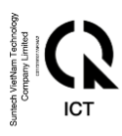 |
||
| Zambia | ✓ |
 |
